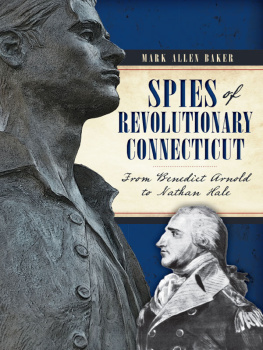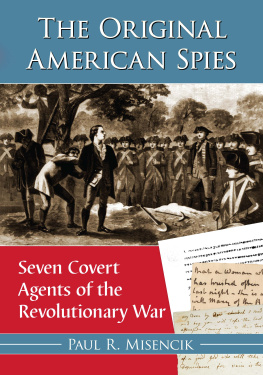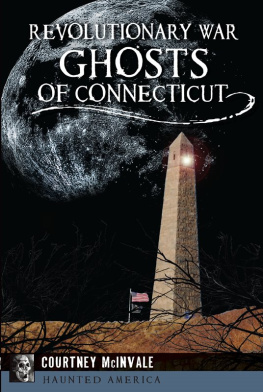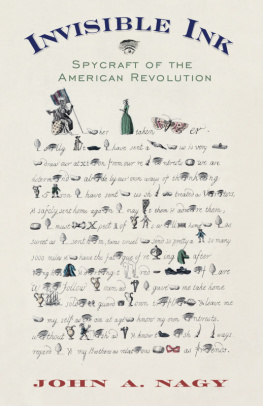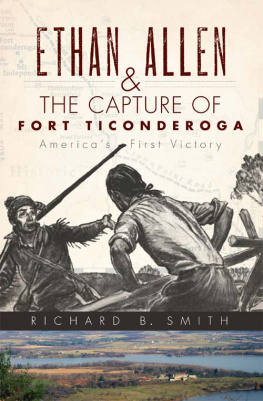

Published by The History Press
Charleston, SC 29403
www.historypress.net
Copyright 2014 by Mark Allen Baker
All rights reserved
Front cover: Image of Benedict Arnold by artist John Trumbull. Courtesy of the Library of Congress, LC-USZ62-68483; Nathan Hale by sculptor Larry Wasiele, Veterans Memorial Green, Town of Coventry, Connecticut, John Elsesser, Town Manager. Photograph by the author.
First published 2014
e-book edition 2014
ISBN 978.1.62584.939.7
Library of Congress Cataloging-in-Publication Data
Baker, Mark Allen.
Spies of revolutionary Connecticut : from Benedict Arnold to Nathan Hale / Mark Allen Baker.
pages cm
print edition ISBN 978-1-62619-407-6 (paperback)
1. Connecticut--History--Revolution, 1775-1783--Secret service. 2. United States--History--Revolution, 1775-1783--Secret service. 3. Spies--Connecticut--Biography. 4. Spies--United States--Biography. I. Title.
E279.B34 2014
327.120922--dc23
[B]
2013050307
Notice: The information in this book is true and complete to the best of our knowledge. It is offered without guarantee on the part of the author or The History Press. The author and The History Press disclaim all liability in connection with the use of this book.
All rights reserved. No part of this book may be reproduced or transmitted in any form whatsoever without prior written permission from the publisher except in the case of brief quotations embodied in critical articles and reviews.
To Flavil Quinn Van Dyke III,
a man of high morals and character, who saw the good in all people and helped many of them achieve their true potential.
A Patriot in every sense of the word and a beloved friend.
In Memoriam
Ford William Baker and James Buford Bird
Contents
Preface
Our cause was just. Our union was perfect. Our intelligence resources were so profound that they echoed from every rolling hill of our northeastern outpost. And when foreign assistance was deemed necessary, we had no further to look than Wethersfield.

Join or Die, the well-known Benjamin Franklin cartoon published in his Pennsylvania Gazette on May 9, 1754. LC-USZ62-9701.
We gratefully acknowledged, as signal instances of the Divine favor toward us, that his Providence would not permit us to be called into this severe controversy until we were grown up to our present strength, had been previously exercised in warlike operation and possessed of the means of defending ourselvesconditions met by our states provisions.
Our Connecticut, the epicenter of freedom, embraced its role. Our hearts fortified with these animating reflections, we most solemnly, before God and the world, declared that, exerting the utmost energy of these powers in all forms, which our beneficent Creator hath graciously bestowed upon us, the arms and intelligence we have been compelled by our enemies to assume, we did so, in defiance of every hazard, with resolve and perseverance. For the preservation of our free will; being with one Connecticut mind, hell-bent without restrain.
May God forever bless our Connecticut Patriots, their families and the ground that so welcomed their footsteps of freedom.
Acknowledgements
This work owes a debt of gratitude to a wealth of individuals and institutions. To the staff at The History Press: Jeff Saraceno, Hannah Cassilly, Darcy Mahan and the entire production staff, I am so very grateful.
My sincerest appreciation to the following: the Town of Brooklyn; the Town of Carmel, New York; the Town of Coventry (John Elsesser); the Nathan Hale Homestead (Beverly York, site administrator); the Town of Essex; the Connecticut River Museum (Amy Trout, curator); the Griswold Inn; the Town of Lebanon (author and historian Alicia Wayland); Governor Jonathan Trumbull Home (Nancy A. Merwin, CTDAR, and Jessi Johnson); the Town of Norwich; the Leffingwell House Museum (Society of the Founders of Norwich, Connecticut); the Town of Wethersfield; the Webb-Deane-Stevens Museum; and the Town of Windsor.
My gratitude to the following Connecticut historical societies (alphabetical by town): Ashford Historical Society; Connecticut Historical Society; Hebron Historical Society (Mary-Ellen Gonci); Lebanon Historical Society Museum & Visitors Center (Donna Baron, director, and Grace Sayles, administrative assistant); Litchfield Historical Society, which includes the Reeve House and Law School and the Ingraham Library; Wethersfield Historical Society; and Windsor Historical Society (Connie Thomas, administrative assistant).
Also to the following libraries/museums: the Library of Congress; National Archives and Records Administration (NARA); the New York Public Library; the Smithsonian Institution; Beinecke Rare Book & Manuscript Library; Yale University, New Haven, Connecticut; and Muse et du Domaine National de Versailles. And thanks to the United States Intelligence Community (IC), a federation of sixteen separate United States government agencies, especially the Central Intelligence Agency.
Editorial review provided by Matthew Robert Baker.
Connecticut inspiration provided by Dana Beck and Brian Brinkman, Kelly and Dennis DiGiovanni, Pete and Jackie Gulbrandsen, Ann and Mark Lepkowski, Jim Risley and Scott and Dianna Wallquist. Also thanks to Mark Brett, Steve Ike, Mark Williamson and Pennsylvania music historian Thomas R. Grosh.
My thanks to family: Marilyn Allen Baker, Aaron and Sharon Baker, Elizabeth Baker, Rebecca Baker and Brad Lane. Joined by my father-in-law, Richard Long, and my wonderful wife, Alison, I was fortunate enough to visit Normandy, France, on the sixty-ninth anniversary of D-Day. It was there that I saw these words from Sergeant John B. Ellery, U.S. First Infantry Division, etched in stone: You can manufacture weapons and you can purchase ammunition but you cant buy valor and you cant pull heroes off an assembly line.
Freedom has a price. God bless our veterans!
Introduction
Every Picture Tells a Story
Suspended inside the United States Capitol Rotunda is a twelve- by eighteen-foot oil-on-canvas filled with more brushstrokes of freedom than any presentation of its kind. Its majesty is a testament to its creator, artist John Trumbull. Underneath, a marquee reads, Congress, at the Independence Hall, Philadelphia, July 4, 1776.
However, it, like much of the American Revolution, has become part of a collection of myths and misrepresentations. The artist titled it The Declaration of Independence but mentioned nothing about a date, location (Pennsylvania Statehouse) or even if the scene ever took place. It did not.
Founder John Adams had lectured Trumbull on the importance of accuracy, stating, Let not our posterity be deluded with fictions under the pretense of poetical or graphical license in reference to the artists historical commission. Veracity is the soul of righteousness, as Thomas Huxley would confirm, not creativity.
Hailing from Pilgrim stock, the artist was born in the picturesque town of Lebanon, Connecticut, on June 6, 1756. The sixth child of Jonathan Trumbull, governor of Connecticut, and his wife, Faith Robinson Trumbull, he entered Harvard at age fifteen and graduated in 1773. His obsession for art engaged the eye of George Washington, who appointed him an aide-de-camp; Trumbull had meandered his way to view and then draw the British position at Boston Neck. Later, in 1777, he resigned his colonels commission and turned back to the canvas.
Next page
